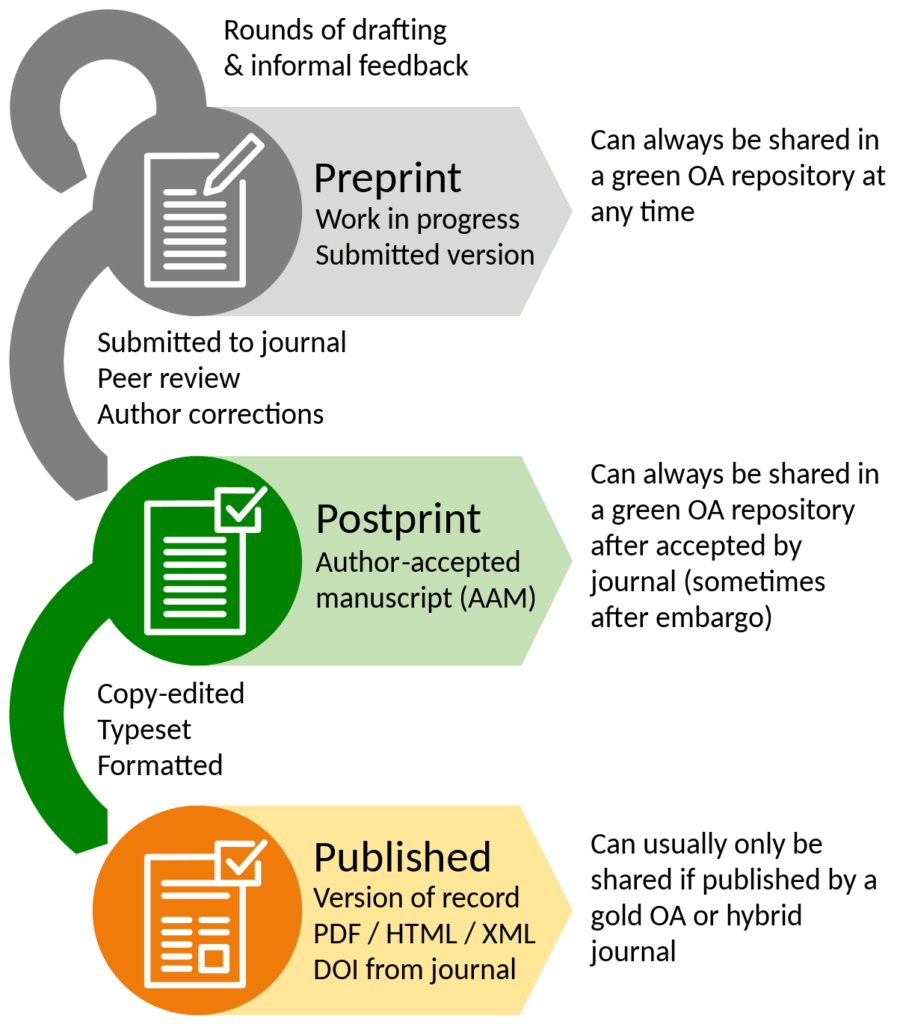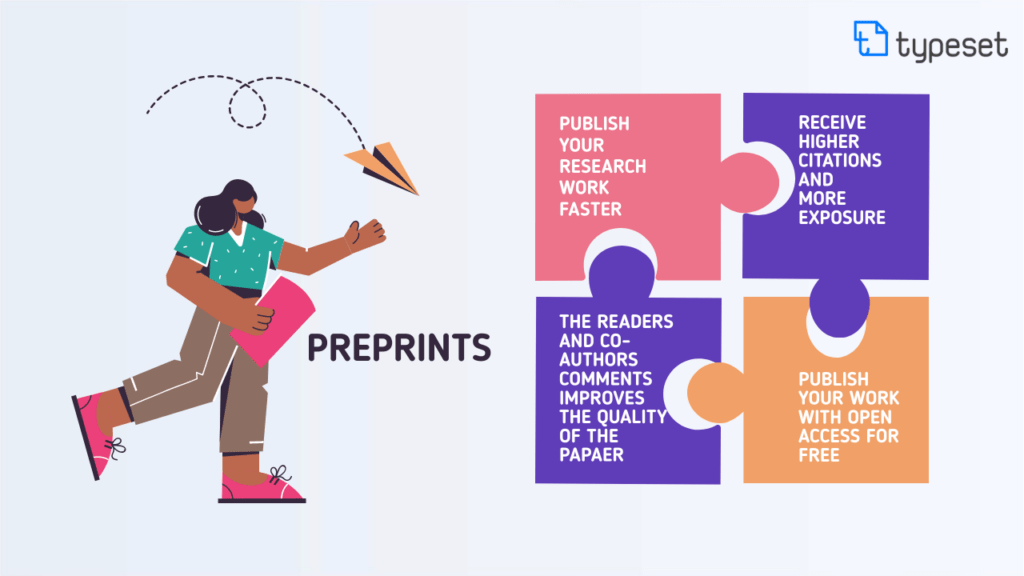The Role and Impact of Preprints in Open Access Publishing
Preprint repositories have become the hotspot for disseminating research articles. As a result, many researchers choose preprint over journal publishing to save publication time and share their research work faster.
If we speak about the acceptance rate, preprints are widely accepted by all open access journals and many subscription journals. In addition, most academic publishers accept preprints based on the publisher’s preprint policies, and it varies from publisher to publisher.

About Preprints – Keeping it Simple
Preprints are the research paper draft preceding peer review and formal publication. In other words, preprints are the bare manuscripts that are neither formatted (edited) by an editor or reviewed by a reviewer. Instead, it is a straight piece of content delivery from the author’s desk. And, it is available free of cost to the readers or other researchers for they can easily refer, cite, or seek knowledge from the research work.
The infographic shown below will help you understand and differentiate between preprint, postprint, and published papers.

However, they undergo primary screening of grammar and plagiarism checks by the author or the publishers before the manuscript submission. Publishing the manuscript draft helps the author share his work more rapidly and openly than taking the formal, traditional publication approach as it takes months to years to publish the article.
Apart from publishing manuscript, preprint also helps the academic community to:
- Archive the final version of articles and make them Green OA (Open Access)
- Publish research datasets, supplemental materials, and codes
- Publish academic journals via overlay models
Over time, the preprint repositories have given rise to various disciplines based on the subject. And the manuscripts are supposed to be submitted on the respective preprint servers.
Let’s have a closer look into the types of preprint servers.
A sneak-peek into the list of popular preprint servers
| Type of repository | Name | What are the subjects it covers |
| Disciplinary Repositories | arXiv | Mathematics, information science, quantitative biology, quantitative finance, electrical engineering and systems, science, physics, and economics |
| ChemRxiv | Chemistry | |
| bioRxiv | Biology and life science | |
| medRxiv | Clinical research | |
| SocArXiv | Social sciences | |
| SportRXiv | Sports, exercises | |
| NutriXiv | Nutritional science | |
| PsyArXiv | Psychological science | |
| Multidisciplinary Repositories | OSF Preprints (supported by Centre for Open Science) | These are a few multidisciplinary preprint servers that support all kinds of preprints |
| Preprints.org | ||
| PrePubMed |
Did You Know?
arXiv is the oldest preprint server created in 1991, and currently, it is sharing nearly two million scholarly articles with a large number of submissions and downloads.
Now that you have learned the types of preprints repositories, let’s hop onto the manuscript submission process and the preferred file format used in preprints to tag the content and store metadata.
The Manuscript Submission
Indeed, the manuscripts are uploaded by the authors in the form of PDF and converted into JATS XML (if preprint servers accept JATS). However, arXiv accepts TeX form manuscripts, making it difficult for non-technical authors to convert the files into a machine-readable format. But, with the evolution of JATS XML as a de facto standard for academic publishing, the preprint servers are now converting the PDF file into JATS XML for tagging the content and storing rich metadata.
Typeset — where I work — is one of the platforms used to easily convert PDF files into JATS XMLs compatible with preprint servers and repositories. You can learn more about JATS XML and their benefits in this article.
So, these were the popular preprint servers or the popular research sharing platforms for authors to disseminate their research works by skipping the long-haul publications.

According to the National Institutes of Health, authors insisted on including the preprints in their “My Bibliography” section and asked to get the Creative Commons license to publish the preprints.
That way, authors’ ideas or works are protected without getting scooped. Also, preprints allow the readers to comment or provide feedback on the content, which helps mold the manuscript and improve the research paper.
For example, check out this tweet from Dan Quintana about the advantages of publishing manuscripts on preprints:
So, this is how preprints are helping authors to disseminate their work without wasting time on formal publication.
But, what is the impact of preprints on open access publishing?
Let’s dive in to know all about it!
Significant Impacts of Preprints on Open Access Publishing
- Facilitating Green open access or self-archiving
- Integration of preprints into traditional publishing
- Overlay publishing models
Let’s look into them in detail;
1. Facilitating Green open access or self-archiving
Although preprints are openly accessible non-peer-reviewed manuscripts, they encourage the Green OA publishing model by allowing the authors to self-archive the final versions of the article and making them available free for the readers immediately or after the embargo period. Therefore, preprints are emerging as the new publishing models.
2. Integration of preprints into traditional publishing
Because of the popularity of preprints, many funders and publishers are integrating preprints into traditional publishing through DOI (Digital Object Identifiers). They accept preprints and encourage the authors to submit the final version of their papers in the form of a journal article. So, the publishers encourage the authors to link the DOI of the published article into the preprints or vice versa. However, people are still questioning the effectiveness of the submission through DOI technique, and publishers are working closely to make it more compatible.
3. Overlay publishing models
Preprint repositories are the principal cause for the development of overlay publishing models.
So what happens in overlay publishing models?
Here, the articles are not directly published in overlay journals. Instead, they act as a medium to link the final version of the preprints and are hosted on the preprint repository, or the final versions are mirrored on the overlay journal website.
The steps involved in the overlay publishing process are;
- The manuscript submissions are posted to the respective journal’s repository.
- The submitted manuscripts undergo a peer-review process, whereas the accepted manuscripts are re-published on the repositories using the registered DOI that certifies the article is the final peer-reviewed version.
One such example for overlay publishing is Discrete Analysis (arXiV overlay journal). This non-profit mathematics journal, launched by Sir Timothy Gowers, provides free access for authors to read and publish.
Overlay publishing is cost-effective compared to traditional publishing, as there are no production expenses for overlay titles. Thus, overlay publishing models are a great way to reduce the publishing cost and encourage transparent publishing practice, including open copyright.
Future of Preprints
Even though the initiatives of preprints are gaining momentum day by day, the viability and authenticity are still being questioned. Also, the debate is getting heated up on the quality of the non-peer-reviewed manuscript compared to traditional publishing.
Despite the odds, the funders and publishers are showing great interest in preprints and encouraging them as a part of future publishing models. So, preprints hold higher chances of seizing a prominent spot in scholarly publishing in the coming years.
This post originally appeared on the blog for Typeset – a complete journal management platform that helps convert your files into JATS XML, PDF, HTML, etc., in seconds that are compatible with preprint servers and repositories.





















































































